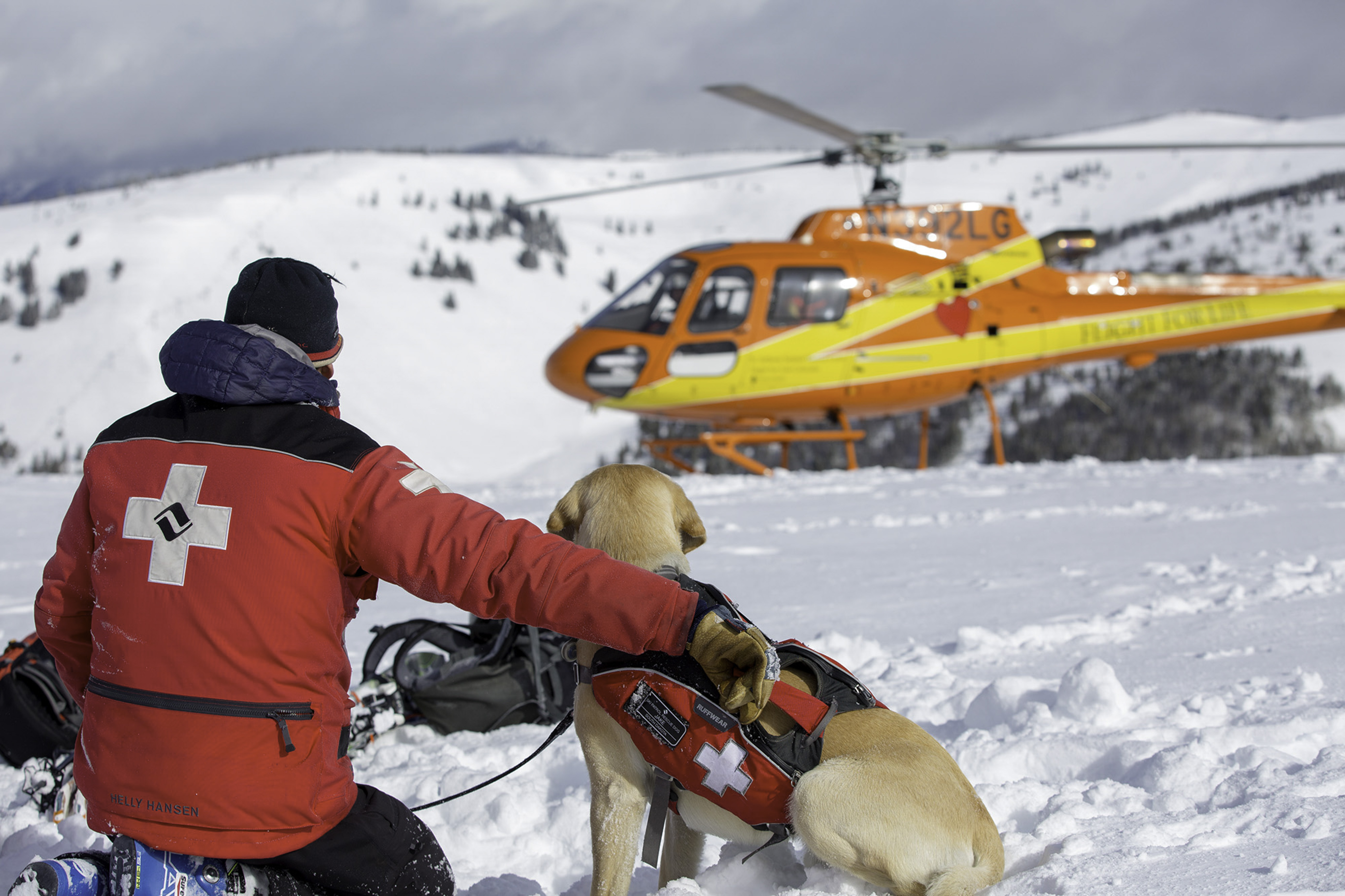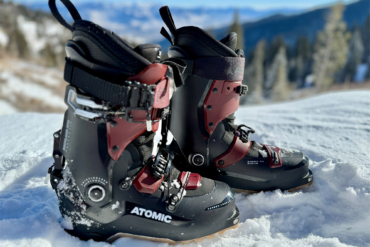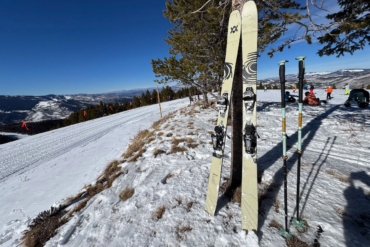Off-piste female explorers can now don durable outerwear made with Helly Hansen’s Lifa Infinity Pro fabric technology.
Helly Hansen’s first-ever backcountry ski outfit with zero chemical additives is finally here for women. That “zero chemical” designation is thanks to Lifa Infinity Pro, an environmentally friendly, waterproof-breathable textile that nixes the need for a toxic chemical DWR treatment.
The brand introduced the tech in two men’s ski jackets last year: the Odin and Elevation Infinity shells for backcountry and freeride skiing. Now it’s expanding to women’s shells too.
Sustainable initiatives are rampant in the outdoor industry — insulation made with low emissions, apparel made with renewable materials, and tents made without dyes. But newer to that front is a welcome alternative for standard DWR treatments.
Helly Hansen engineers its “groundbreaking technology” with a proprietary hydrophobic Lifa fiber, which it’s been using for 50 years. Helly pairs the Lifa fiber with a polypropylene membrane, which has microscopic holes that allow vapor out, yet prevent water from seeping in.
The result is apparel that’s waterproof, wind-resistant, and breathable without any durable water-repellent (DWR) chemicals. The qualities are permanent too.

Topping off the environmental push, Helly Hansen also made the shells solution-dyed. This means that pigment is added to the yarn during manufacturing versus its traditional post-production addition. This avoids the use of chemicals and saves lots of water.
Named the Odin Mountain Infinity collection, the women’s off-piste kit includes an insulated jacket, shell bib, and shell jacket. The designs were developed with input from the Norwegian People’s Aid search-and-rescue teams for mountain travel.
We tested the waterproofness, performance, and, of course, durability of these three pieces of backcountry apparel against the elements.
In short: The Women’s Odin Mountain Infinity Insulated Jacket, 3L Shell Bib, and 3L Shell Jacket are extremely waterproof, breathable, and wind-resistant. The Lifa Infinity Pro successfully replaces those nasty DWRs.
Each silhouette has top-notch characteristics for a well-supported backcountry adventure. For female backcountry skiers and splitboarders, these jackets and bibs are among the most comfortable, sustainable, and functional outerwear options I’ve tried to date.
Women’s Odin Mountain Infinity Insulated Jacket: Review

This spring, I tested the Odin Mountain Infinity Insulated Jacket ($800) in a range of weather and snow conditions while splitboarding, backcountry skiing, and snowmobiling in my backyard: the Elk Mountains surrounding Crested Butte, Colorado.
I was impressed with the streamlined design and warmth-to-weight ratio. For snowmobile-accessed high-alpine terrain, this three-layer jacket kept me warm as I drove. I paired it with a synthetic long-sleeve base layer.
The jacket boasts 80 g of LifaLoft insulation (codeveloped with PrimaLoft) and is 20% lighter than standard polyester insulation. On straightaways, I reached 45 mph in windchill of at least 16 degrees F, but I never got cold.
When it snowed, as I snowmobiled or when I was splitboarding, the jacket didn’t absorb any moisture, which beaded up on the surface.
For uphilling, I opted for a shell, and this insulated layer easily compressed in my loaded backcountry pack. The insulated hood fits over my helmet while transitioning on ridgelines during gusts of 24 mph. I didn’t test the jacket with a harness, but the hem’s circumference is roomy and could sit over gear if preferred.
Two interior dump pockets are big enough for my splitboard skins on descents. Four large external pockets are spacious — my huge phone fits in each one — and are accessible with a pack on. There’s a RECCO reflector to assist search-and-rescue teams using RECCO detectors if the traveler is lost or buried in an avalanche.
It’s not a dealbreaker, but I occasionally struggled with the underarm vents when my pack was on. I wish the zippers were a smidge closer to the chest.
A bit of cloth could be removed from the lower back area, which tended to fold over when I pulled on a pack. Also, I prefer wider Velcro closures on wrist cuffs, which withstand blustery days better.
Conclusion
This high-quality insulated jacket is lightweight, tenacious, packable, and environmentally friendly. It’s an excellent, functional, and warm choice for backcountry adventures.
The men’s Odin Infinity Shell was updated with 80 g of insulation, leading to the Odin Mountain Infinity Insulated Jacket ($800) for him.
Women’s Odin Mountain Infinity 3L Shell Jacket: Review

If 80 g of LifaLoft insulation is too much protection, pull on the non-insulated Women’s Odin Mountain Infinity 3L Shell Jacket ($700).
I wore this shell while skinning in a wintry spring climate. There was usually cloud coverage mixed with spurts of sunshine. Temperatures ranged from 16 to 40 degrees Fahrenheit, and gusts peaked around 30 mph.
Typically, I took 1,000-foot continuous climbs with the underarm vents open and never felt hot or clammy. This shell is breathable, yet provides a solid barrier against wind and fairly wet, heavy snowfall.
Aside from the lining, this three-layer shell is similar to the Odin Mountain Infinity Insulated Jacket. One big difference is the pocket configuration. This shell has two exterior hand pockets and one chest pocket.
Inside, there’s a small mesh pocket and another tiny pocket with a zip closure. I used the outermost big pockets during tours.
One drawback — the powder skirt has a snap attachment point in the back that occasionally got stuck beneath my pack while skinning up. I could usually move it out of the way. If this bothers others, the powder skirt is removable.
Conclusion
This eco-conscious shell is soft, quiet, and comfortable. The design is easy to move in while climbing and, if the temps are warmer, on descents.
Women’s Odin Mountain Infinity 3L Shell Bib: Review

We reviewed the original Odin Bib, and it’s one of our top-rated designs for women. The most prominent update of the Women’s Odin Mountain Infinity 3L Shell Bib ($500) is the overhaul of the DWR treatment. As a result, the bib is constructed sustainably and is lighter too.
Despite how lightweight these bibs feel, I was surprised by their waterproof, breathable, and wind-resistant protective qualities, even while snowmobiling. Note that the upgrade nearly doubled the price.
This non-insulated bib has rugged reinforcement along the interior ankle, where kick-turns can slash fabric. The tough material protects the pants, like when I jump side to side over my snowmobile seat for an opposite-foot-forward position on the running boards.
I wish this coating wrapped around the entire ankle, though. I can see wear and tear on the outermost sides of both pant legs.
When I get toasty on ascents, I love the ease of the double-zippered leg vents. I appreciate the huge thigh pockets, which I use for my phone and to shove glove liners or face masks.
I wear my beacon affixed to a chest carrier, which integrates fine with the slender suspenders. Also, the pant leg and stretch snow gaiters slid seamlessly over my ski or splitboard boots.

A drop seat is a must. This one works well but could be improved if the zipper was a tad more forward. The zipper usually rested beneath the underside of my pack, which was heavy. I needed to set down my bag for bathroom breaks.
Conclusion
This bib design is stylish, feminine, and flexible while being steadfast and supportive. After riding down steep terrain with tons of sluffing and face shots, the pants showed no sign of absorbing snow or water.
DWR: What Is It?
The external face of snow and rain outerwear typically features a DWR treatment. DWR prevents outerwear from becoming saturated and allows precipitation to bead and roll off, but eventually, the coating wears out.
Several of my hardiest waterproof/breathable jackets and pants have turned into a wet mop during whiteouts or downpours. The fabric soaks up moisture, gets heavy, and the inside of the jacket feels wet and clammy.
That gear failure happens when DWR chemicals degrade due to abrasion, dirt, and body oils. The fix is simple. Make sure your apparel is clean, and then reapply a DWR layer via a spray-on or wash-in product of your choice.
But if environmental sustainability and health safety are a top priority, then today’s industry-standard DWR treatments are a problem. (Luckily, there are one or two PFC-free DWR sprays on the market, although many sprays on market still contain PFCs.)
Why Are Outdoor Industry Brands Replacing DWR?
Traditional DWR treatments contain various fluorocarbons, extremely resilient chemicals that extend a product’s durability and life. However, fluorocarbons (aka perfluorocarbons or PFCs) are toxic and can’t biodegrade.
The World Health Organization’s International Agency for Research on Cancer found that these harsh compounds pollute drinking water and air and that they are carcinogenic for humans.
Another University of Oxford study linked fluorocarbons to infertility. Researchers have also found that these chemicals impact the environment and wildlife such as dolphins and porpoises.
Last year, the European Union even banned perfluorooctanoic acid (PFOA), a type of fluorocarbon, and related compounds. The Environmental Protection Agency recently issued a regulation to control fluorocarbons nationwide. Now, companies need EPA approval to manufacture or import products with perfluorooctanoic acid (PFAS).
A handful of other outdoor industry brands are working on DWR alternatives. Among the pioneers, HeiQ, a Swiss textile innovator, develops PFC-free DWRs. Deuter, a manufacturer specializing in packs, completely cut out PFCs in spring 2020.
Black Diamond received a 2020 Outside Magazine Gear of the Year award for the HighLine Stretch Shell with a PFC-free water-repellent finish. And Flylow Gear launched four winter apparel pieces with OmniBloq, a non-PFOA DWR finish.
It’s worth noting this isn’t a complete list of brands seeking DWR alternatives — Marmot and The North Face both have several garments with PFC-free DWR treatments as well.
Helly Hansen: Expanding Lifa Infinity Pro
Helly Hansen is quickly burgeoning this DWR alternative across its apparel. To kick off the robust expansion, it debuted the Odin 9 Worlds Jacket for men and women this spring, tailored to mountain rescue personnel and alpinists.
Then, Lifa Infinity Pro will roll out a wide variety of more winter outerwear this fall. That includes a premier in men’s snow pants — the Elevation Infinity 2.0 Pant ($550) for inbounds freeride skiing and snowboarding.
The men’s Elevation Infinity 2.0 Jacket is an overhaul of last year’s shell ($750). Brand new, the Chugach Infinity Powder Suit is available for guys ($1,000) too.
To serve ladies’ resort days, the Elevation Infinity Shell Jacket ($750) and Bib Pant ($600) will feature Lifa Infinity Pro. (Men can also grab an Odin Mountain Infinity 3L Bib for $500.)
The Women’s Odin Mountain Infinity Insulated Jacket, 3L Shell Bib, and 3L Shell Jacket are a solid, enduring choice for splitboarders and ski tourers that also allows them to invest in earth-friendly apparel. The three pieces will be available in August 2021.









